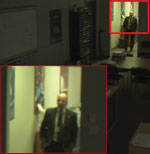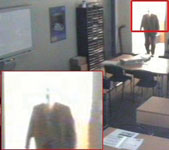
Megapixel cameras are becoming the rage with the ability to zoom digitally into an image and extract that face or key detail for an image or number plate.
Recent articles and e-mails, with the number of advertisements featuring megapixel cameras prompts some discussion on the merits and preferences for these high resolution cameras; as there are areas to watch out for and considerations to be made.
Extracting that key bit of information or drilling down into the image to provide facial identification is a function of pixel density. The UK Home Office has agreed upon a rating of 40 pixels in a foot or 133 pixels in a metre to give reasonable facial identification. A pixel is a square as opposed to the traditional dot that we see from an analogue signal as on a TV set. One first needs to understand that the basis of any calculation needs to know the pixel capability of the CCD or CMOS chip and how the shuttering mechanism is used to provide exposure of the image. There are differences between CCD and CMOS chips that must be considered but in this scenario the focus is on the shutter and the ability to gain uniformity of image.
Shutter performance is usually a roller or global mechanism, providing the basis for interlaced scanning - the traditional CCTV route, progressive scanning as seen in IP cameras, and variations of line scanning for niche market solutions. Capturing an image through a global shutter will expose the complete picture in one go as opposed to a rolling shutter, which can cause some imbalance on lighting and exposure. Each of these scanning mechanisms will provide differing results that will ultimately affect the quality of picture received and are worth more consideration before making your choice.
The global shutter can be used with either the CCD or CMOS chip and dependent upon the application will normally give a better balanced image, assessed at one exposure, greater uniformity across the complete image resulting in an ability to differentiate between a very light part of the photo and a darker area with excellent contrast. Using a rolling shutter one is more likely to be affected by light differentiation creating blooming where there is excessive lighting, blurring with movement or poor differentiation in darker areas. This is shown in the picture below where the top global shutter image has better contrast and therefore any area of the image can be clearly seen once enhanced:


Pixel-perfect
The reason for careful consideration is the range of cameras that are available offering anything from 2 MP (megapixels) right through to 21 MP and even an 85 MP camera in development. Pixel calculation is based upon the number of pixels used both horizontally and vertically to make up a full picture. A camera uses 10 240 pixels horizontally and 2048 pixels vertically, described as 10 240 (H) x 2048 (V) which give a multiplied total of 20 971 520 or rounded to 21 million pixels; a 21 MP camera.
To get to the 21 MP pixel count this particular camera uses a line scanning system and therefore the horizontal count is based upon one horizontal pixel and 10 240 line scans to achieve the horizontal total of 10 240 pixels across a 90° field of view (FOV). What this means is that to find the key focal point for facial identification will mean calculating through a formula to find the required focal length. One does this by applying the 133 pixel count for facial ID to the horizontal and vertical measurements giving us 10 240/133 and 2048/133 which equates to 77 m (H) and 15 m (V). From this we can ascertain the key focal point using R=C/2Pi where R is radius, C is applied circumference and Pi is 3,142, therefore the calculation becomes R = 77 x 4 (as the FOV is 90°) divided by 2 x 3,14, equating to 49 metres.
So, with this camera effective facial recognition will be achieved at up to 49 m from the camera depending upon the focus.
Understanding this aspect of the camera use is critical to avoid falling into the trap of seeing an amazing picture in demonstration and only when an important piece of evidence is required discovering that the facial capture is insufficient for your needs; ie, no facial ID.
Consider a football field which has dimensions of 90-120 m length and 45-90 m width, a stadium built around the field may extend back a further 50 m on all sides. The user will need to consider a camera and lens capable of handling the greater distance. Within the stadium there are also the issues of lighting and darkness with excessive contrasts depending upon the time of the game, sunlight, overhanging stands, spotlight, and surrounding illumination. The use of a global shuttered camera with a good pixel ratio will help in this regard as the focal point can be adjusted by merely changing lenses.
Consider a 16 MP camera: the pixel ratio of 4873 (H) by 3218 (V) pixels will remain the same if you use a 24 mm (74° lens) compared to an 85 mm (24° lens); all that will change is the key focal point. In this regard, using the same formula as above represented by the focal point R=C/2Pi where R (radius) = C (circumference) divided by 2 x Pi (3,14), with C as 360° divided by the 24° of the lens multiplied by the horizontal length (R = 360/24 x (4,873/133)) or 549 m giving a total of 87 m as the focal point for facial ID for an 85 mm lens. Note that the focal point needs to be adjusted to the hyperfocal distance which will give an effective depth of FOV from some 20 m or more in front of this point to much further out.
The dynamics of the above formulae may seem excessive and difficult at first to understand. The concept of realising how to get the right pixel count at a set distance will allow the facial or similar identification to be achieved at a required point. Choosing a camera based purely on its megapixel rating and believing 'the higher the better' is not the way to go. Laying out the various fields of view of each camera and understanding what results it will give at the time of an incident is as important as deciding on a budget and finding the right company to purchase from.

© Technews Publishing (Pty) Ltd. | All Rights Reserved.